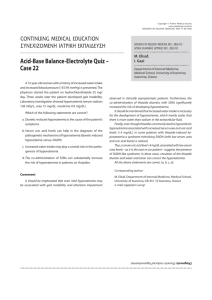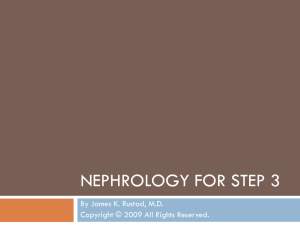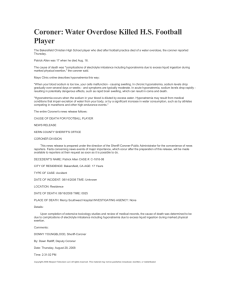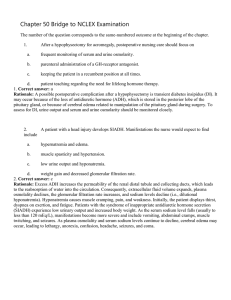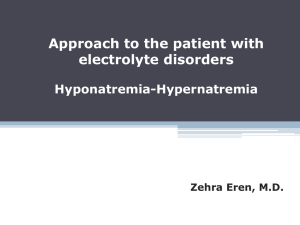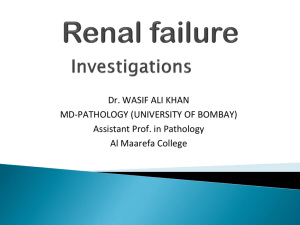normal values, interpret results
advertisement
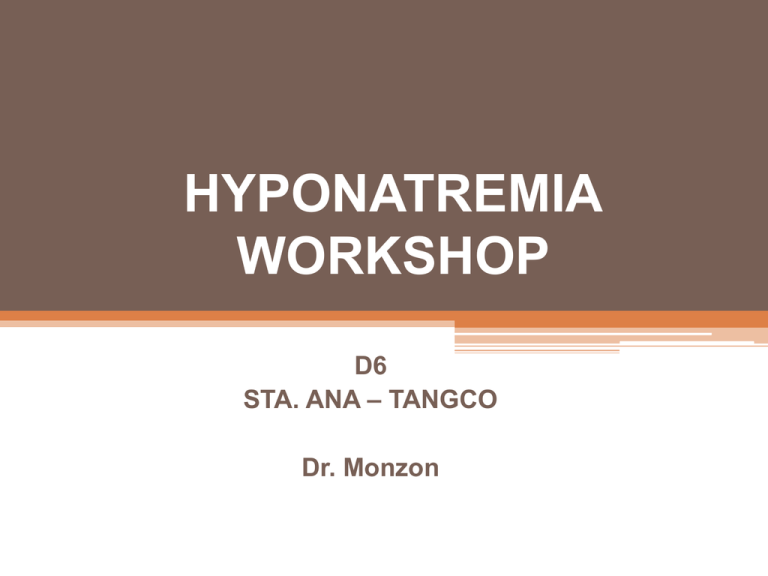
HYPONATREMIA WORKSHOP D6 STA. ANA – TANGCO Dr. Monzon Salient features HISTORY • 60 year old female • cc: vomiting • Fever, dysuria, frequency • Headache, body malaise, nausea • (-) epigastric pain, diarrhea • (-) smoker and alcohol beverage drinker • (+) HPN on telmisartan 40 mg and hydrocholothiazide 12.5 mg Salient features PHYSICAL EXAMINATION • wheel-chair-borne • Orthostatic hypotension LABORATORY FINDINGS • Presence of infection ▫ Leukocytosis with predominance of neutrophils ▫ Slightly turbid urine ▫ Hyaline cast, Pyuria, Bacteruria • Increased serum creatinine • Decreased serum sodium = hyponatremia GUIDE QUESTIONS 1. What is you diagnosis? HYPOTONIC HYPONATREMIA • a plasma Na+ concentration less than 135 mmol/ L (patient: 123 mmol/L) HYPONATREMIA Pseudo-hyponatremia N plasma osmolality ↑ plasma osmolality Hypoosmolal hyponatremia 1° Na+ loss 1° water gain 1° water gain with 2° water gain Hyperlipidemia Hyperglycemia Skin loss Hypothyroidism Heart failure Hyperproteinuria Mannitol GI loss AVP release Hepatic cirrhosis Renal loss SIADH Nephrotic syndrome Chronic renal insufficiency 1. What is the basis for your diagnosis? ▫ ▫ ▫ ▫ ▫ ▫ ▫ ▫ Infection/ Fever Vomiting Nausea Frequency Serum Na = 123mmol/L Orthostatic hypotension Medications Neurologic manifestations Basis for diagnosis • Vomiting ▫ Results in disturbances in acid-base balance, dehydration and electrolyte depletion ▫ Na+ loss • Infection ▫ fever sweating Na+ loss • Frequency ▫ Na+ loss in urine Basis for diagnosis • Nausea ▫ ADH H2O retention hypoosmolarity • Serum Na+ 123 mmol/L = Hyponatremia • Orthostatic hypotension ▫ Sustained drop in systolic pressure (≥ 20 mmHg) or diastolic pressure (≥ 10 mmHg) within 3 minutes of standing ▫ In nonneurogenic causes (i.e. hypovolemia) the BP drop is accompanied by a compensatory increase in HR (>15bpm) Basis for diagnosis • Medications ▫ Telmisartan - ARB angiotensin II Na+ reabsorption in tubules Na + excretion Na + loss ▫ Hydrochlorothiazide - Diuretic “diuretics-induced hyponatremia” is almost always due to thiazide diuretics Na + reabsorption in tubules Na + excretion Na+ loss ** Creatinine levels may increase when ACE inhibitors (ACEI) or angiotensin-II receptor blockers (ARBs) Basis for diagnosis • Neurologic symptoms ▫ Related to osmotic water shift increased ICF volume (cerebral edema) ▫ Severity is dependent on rate of onset and absolute decrease in plasma Na concentration ▫ As plasma concentration falls… Nausea, body malaise, headache, lethargy, confusion and obtundation ▫ Plasma concentration < 120 mmol/L Stupor, seizures, coma 2. What other laboratory tests are needed to be requested for the patient? 4 laboratory findings provide useful information for the diagnosis of hyponatremia ▫ ▫ ▫ ▫ Serum osmolality Urine osmolality Urine Na+ concentration Urine K+ concentration ▫ Serum glucose & lipid profile* Plasma Osmolality High Normal Hyperglycemia Hyperproteinemia Mannitol Hyperlipidemia Low Maximal volume of maximally dilute urine (<100mosmol/kg) Bladder Irrigation Yes No ECF Volume Increased Normal Heart Failure SIADH Hepatic Cirrhosis Exclude hypothyroidism Nephrotic Syndrome Exclude adrenal insufficiency Renal Insufficiency Primary polydipsia Reset osmostat Decreased Urine Na Concentration >20mmol/L <10mmol/L Extrarenal Na loss Na wasting nephropathy Remote diuretic use Diuretic Remote vomiting Vomiting Hypoaldosteronism 2. What other laboratory tests are needed to be requested for the patient? a. Serum osmolarity ▫ confirmation of true hypoosmolar hyponatremia ▫ determines fluid status to establish classification of hyponatremia abnormally low in patients with hypoosmolar hyponatremia normal or elevated in patients with hypertonic hyponatremia due to serum hyperglycemia. Serum osmolarity Normal Range: 280 to 300mOsm/kg Total osmolality (mOsm) = 2 (Na + K) + Glucose(mg/dl)/18 + BUN(mg/dl)/2.8 = 2(123 + 3.7) + 98/18 + 20/2.8 = 2(126.7) + 5.44 + 7.14 = 265.98 Hypotonic Hyponatremia 2. What other laboratory tests are needed to be requested for the patient? b. Urine osmolality ▫ may be helpful in establishing the diagnosis of SIADH ▫ The appropriate renal response to hypoosmolality is to excrete the maximum volume of dilute urine ▫ Patients with other forms of hyponatremia and appropriately depressed levels of ADH have urine osmolarities below 100 mOsm/L. 2. What other laboratory tests are needed to be requested for the patient? c. Urine Sodium Level ▫ to identify renal from nonrenal causes If due to nonrenal causes eg, vomiting, diarrhea, fistulas, GI drainage, third spacing of fluids have avid renal absorption of tubular sodium and urine sodium levels of less than 20 mEq/L If due to renal causes eg, diuretics, salt-losing nephropathy, aldosterone deficiency have inappropriately elevated urine sodium levels in excess of 20 mEq/L. 2. What other laboratory tests are needed to be requested for the patient? d. Urine Potassium Level ▫ Potassium levels often change with sodium levels ▫ ↓ Na+, ↑K+ 2. What other laboratory tests are needed to be requested for the patient? • Serum glucose concentration ▫ Several physiologic states (e.g. hyperglycemia) exist in which correct laboratory analysis yields low serum sodium levels, but these levels do not reflect a true hypoosmolar state. ▫ Accumulation of extracellular glucose induces a shift of free water from the intracellular space to the extracellular space ▫ Serum sodium concentration is diluted by a factor of 1.6 mEq/L for each 100 mg/dL increase above normal serum glucose concentration 3. How will you manage the patient’s hyponatremia? GOALS: 1. To raise the plasma Na+ concentration y restricting water intake and promoting water loss 2. To correct underlying disorder MANAGEMENT • Check vital signs every 2 hrs • Check for changes neurologic status – seizures • Treat with Isotonic Saline (0.9 NaCl – 154 meq/L) • Calculate sodium deficit Calculation of sodium deficit: Target Na: 125 – 135 mEq/L (average: 130 meq/L) Na deficit = 0.6 x wt. in kg X (desired Na – actual Na) = 0.6 x (50 kg) x (130 – 123) = 210 mEq/L Correction rate: <0.5 meq/L/hr • First 8 hrs – 50% of calculated Na • Next 16 hrs – other 50% • Risk of development of Osmotic demyelination syndrome in rapid correction of hyponatremia 3. How will you manage the patient’s hyponatremia? • Do not give hypertonic saline may result to overcorrection Central Pontine Myelinosis • Do not give hypotonic fluids until serum Na is > 125 mg/L • Correct K+ deficit RT, 60 y/o female • CC: vomiting • 1 week PTA --- fever dysuria frequency self-medicated with Paracetamol & unrecalled antibiotics • 2 days PTA --- headache, body malaise, nausea & vomiting (-) epigastric pain, diarrhea • ROS: unremarkable • Personal History: ▫ non-smoker, non-alcoholic beverage drinker • Past medical history: ▫ known hypertensive for 10 years Telmisartan 40 mg Hydrochlorothiazide 12.5 mg tablet OD discontinued amlodipine due to bipedal edema • Family History: ▫ (+) hypertension – father & mother ▫ (-) Diabetes mellitus ▫ (-) Tuberculosis Physical Exam • Conscious, coherent, wheel-chair-borne • Weight 50 kg • Vital signs ▫ BP: 120/80 supine; 90/60 sitting ▫ CR: 90/min supine; 105/min sitting ▫ RR: 20/min ▫ T: 37o C • Warm, dry skin, dry buccal mucosa, no active dermatoses Physical Exam • • • • Pink, palpebral conjunctivae, anicteric sclera Supple neck, JVP 3 cm at 30o angle Symmetrical chest expansion, clear breath sounds Adynamic precordium, AB 5th at LICS, MCL, no murmurs • Flabby abdomen, w/ normoactive bowel sounds, soft, non-tender • Extremities: (-) edema, pulses full and equal • Neurological exam: normal Drugs Generic name Paracetamol Telmisartan Hydrochlorothiazide Amlodipine Type of drug NSAIDs ARB Diuretic Indication analgesic, antipyretic essential HPN HPN CCB HPN & angina Laboratory results: CBC RESULTS N.V. Hemoglobin 0.132 g/dL 12 – 16 g/dL ↓ Hematocrit 0. 35 0.36 -0.46 ↓ WBC 12.5 x 109/L 4.5 – 11 x 109/L ↑ Neutrophils 0.88 0.40 – 0.70 ↑ Lymphocytes 0.12 0.22 – 0.44 ↓ ** Increased WBC with predominance of neutrophils indicate presence of bacterial infection Laboratory results RESULTS N.V. FBS 98 mg/dL < 100 mg/dL N BUN 20 mg/dL 10 – 20 mg/dL N Serum creatinine Serum Na 0.9 mg/dL < 1.5 mg/dL ↑ 123 mmol/L 136 – 145 mmol/L ↓ Serum K 3.7 mmol/L N 3.5 - 5.0 mmol/L Urinalysis Result Normal Appearance Yellow, slightly turbid ♥ pH 6.0 Straw – dark yellow, clear – hazy 4.5 – 7.8 Specific gravity Albumin 1.020 1.003-1.029 (-) (-) Sugar (-) (-) Urinalysis Result Normal 5/hpf ♥ 0-2/lpf Pus cells 10-15/hpf ♥ Up to 5/hpf RBC 0-5/hpf Epithelial cells 2-5/hpf, nondysmorphic Few Bacteria Moderate ♥ (-) Hyaline casts Few Slightly turbid urine • Cloudy urine may not be pathologic • Turbidity may be due to precipitation of crystals or non-pathologic amorphous salts • Materials that can cause turbidity: ▫ Phosphate ▫ RBCs ▫ Uric acid ▫ Ammonium urates ▫ Leukocytes ▫ Bacterial growth ▫ Mucus ▫ Blood clots ▫ Contamination ▫ Increased number of epithelial cells ♥ Hyaline Casts • Can indicate mild to severe renal disease when increased in numbers ▫ proteinuria of renal (eg., glomerular disease) ▫ extra-renal (eg., overflow proteinuria as in myeloma) origin. • Can be found in healthy individuals after heavy exercise ♥ Pyuria • Greater numbers of pus cells generally indicate the presence of an inflammatory process somewhere along the course of the urinary tract ▫ Acute infection of kidney (pyelonephritis) ▫ Cystitis (bladder) ▫ Urethritis (urethra) • Pyuria often is caused by urinary tract infections, and often significant bacteria can be seen on sediment preps, indicating a need for bacterial culture. ♥ Bacteruria • Can be contamination from external sources • Rapidly multiply in improper stored specimen • With increased WBCs, indicative of urinary tract infection ♥


